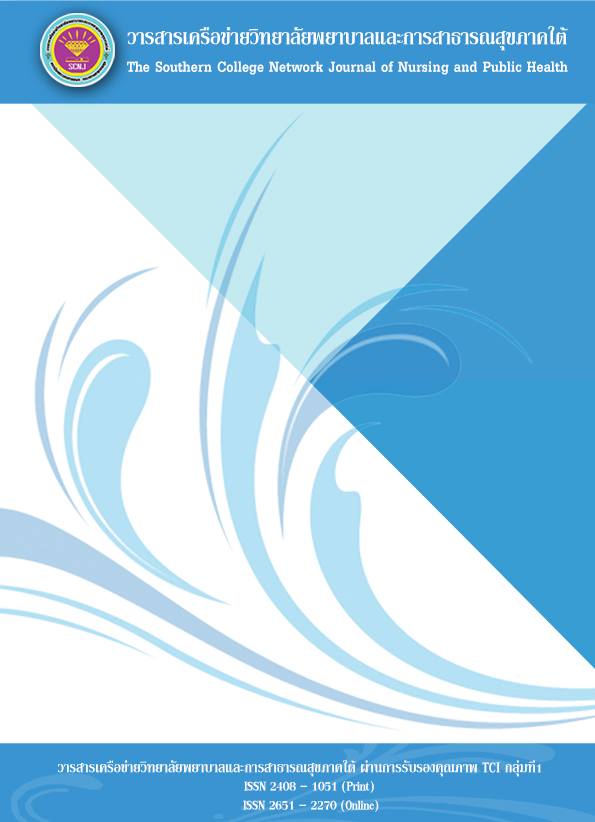The Mindfulness-Based Nursing Rehabilitation Program (MNRP) among Thai Buddhist Patients with Lower Extremity Injury: A Pilot Study
คำสำคัญ:
Lower Extremity Injury, Mindfulness-Based Nursing Rehabilitation Program, Physical Functioning, Psychological Distress, Spiritual Well-Beingบทคัดย่อ
The purpose of this pilot study is to explore the feasibility and the effects of The Mindfulness-Based Nursing Rehabilitation Program (MNRP) on physical functioning, spiritual well-being and psychological distress among Thai Buddhist Patients with lower extremity injury. Participants comprised of three males and two females, a purposive sampling aged 19 - 38 years, suffering from femoral fracture and admitted to a tertiary hospital located in the Southern of Thailand. The MNRP was developed based on knowledge of the cognator sub-system of Roy’s Adaptation Model and mindfulness as the path of the Nobel Truths. The MNRP was started on the third day after injury and continued after discharging from the hospital. There were four instruments for assessing physical functioning, spiritual well-being and psychological distress including muscle strength (MS), passive range of motion (PROM) of hip and knee joint, Spirituality Index of Well-Being (SIWB) and Brief Symptom Inventory-18 (BSI-18) at the baseline, 1 and 3 months after injury. Quantitative data were compared across time to take the progression.
The findings demonstrated the MNRP is feasible and participants had a high level of physical functioning, and spiritual well-being, also low level of psychological distress. Most participants dramatically improved muscle strength and passive range of motion of hip and knee.
Furthermore, four of five participants returned to the same work within 3 months of the injury. To conclude, the MNRP is feasible and potentially efficacious.
เอกสารอ้างอิง
Clay, F., Fitzharris, M., Kerr, E., McClure, R., & Watson, W. (2012). The Association of Social Functioning, Social Relationships and the Receipt of Compensation with Time to Return to Work Following Unintentional Injuries to Victorian Workers. Journal of Occupational Rehabilitation, 22, 363-375.
Daaleman, T. P., & Frey, B. B. (2004). The Spirituality Index of Well-Being: A new Instrument for Health-Related Quality of Life Research. Annals of Family Medicine, 2: 499-503.
Delgado-Pastor, L. C., Perakakis, P., Subramanya, P., Telles, S., & Vila, J. (2013). Mindfulness (Vipassana) Meditation: Effects on P3b Event-Related Potential and Heart Rate Variability. International Journal of Psychophysiology. https://dx.doi.org/10.1016/ j.ijpsycho.2013.07.006
Frey, B. F., Timothy, P. D., & Peyton, V. (2005). Measuring a Dimension of Spirituality for Health Research: Validity of the Spirituality Index of Well-Being. Research on Aging, 27, 556-577.
Grabovac, A., Lau, M., & Willett, B. (2011). Mechanisms of Mindfulness: A Buddhist Psychological Model. Mindfulness, DOI 10.1007/s12671-011-0054-5
Kee, Y. H., & Liu, Y. (2011). Effects of Dispositional Mindfulness on the Self-Controlled Learning of a Novel Motor Task. Learning and Individual Differences, 21, 468-471.
Kellezi, B., Coupland, C., Morriss, R., Beckett, K., Joseph, S., Barnes, et.al. (2016). The Impact of Psychological Factors on Recovery from Injury: a Multicentre Cohort Study. Social Psychiatry and Psychiatric Epidemiology, 52(7), 855-866. doi:10.1007/s00127-016-1299-z.
Keng, S., Smoski, M., & Robins, C. (2011). Effects of Mindfulness on Psychological Health: A Review of Empirical Studies. Clinical Psychology Review, 31, 1041-1056.
Luangpor Teean. (2013). To One that Feels. 20th ed. Wat Sanamnai, Bangkok, 2013, p. 93-102.
Magill, R. A. (2011). Motor Learning and Control. (9th ed.). New York, NY: McGraw-Hill.
Malouin, F., Jackson, P. L., & Richards, C. L. (2013). Towards the integration of mental practice in Rehabilitation Programs. A Critical Review. Frontiers in Human Neuroscience, 7, 576. doi:10.3389/fnhum.2013.00576
Marchand, W. (2012). Mindfulness-Based Stress Reduction, Mindfulness-Based Cognitive Therapy, and Zen Meditation for Depression, Anxiety, Pain, and Psychological Distress. Journal of Psychiatric Practice, 18, 233-252.
Meijer, R. R., de Vries, R. M., & van Bruggen, V. (2011). An Evaluation of the Brief Symptom Inventory–18 Using Item Response Theory: Which Items are Most Strongly rRelated to Psychological Distress?. Psychological Assessment, 23, 193-202.
O’ Dell, M. W., Lin, C. D., Singh, J. R., & Christolias, G. C. (2016). The Physiatric History and Physical Examination. In D.X. Cifu (Ed.). Braddom’s Physical Medicine & Rehabilitation (5thed.) (pp.27-36). Canada: Elsevier.
Roy, S. C. (2009). The Roy Adaptation Model. (3rd ed.). New Jersey: Prentice Hall.
Skogstad, L., Toien, K., Hem, E., Ranhoff, A. H., Sandvik, L., & Ekeberg, O. (2014). Psychological Distress After Physical Injury: A One-Year Follow-Up Study of Conscious Hospitalised Patients. Injury, 45, 289-298.
Sutherland, A., Suttie, S., Alexander, D., & Hutchison, J. (2011). The Mind Continues to Matter: Psychologic and Physical Recovery 5 Years After Musculoskeletal Trauma. Journal of Orthopedic Trauma, 25, 228-232.
Thaiyanond, A. (2010). Paramattha-Sacca. Retrieved June 2, 2013 from https://www. paramatthasacca.com
Toien, K., Skogstad, L., Ekeberg, O., Myhren, H., & Bredal, I. (2012). Prevalence and Predictors of Return to Work in Hospitalized Trauma Patients During the First Year After Discharge: A Prospective Cohort Study. Injury, 43, 1606-1613.
Tsai, J., Harpaz-Rotem, I., Pietrzak, R., & Southwick, S. (2012). The Role of Coping, Resilience, and Social Support in Mediating the Relation Between PTSD and Social Functioning in Veterans Returning from Iraq and Afghanistan. Psychiatry, 75, 135-149.
Tutton, E., Seers, K., & Langstaff, D. (2012). Hope in Orthopedic Trauma: A Qualitative Study. International Journal of Nursing Studies, 49, 872-879.
Varadhammo, V. (1996). Suffering and No Suffering. USA: Buddhadharma Meditation Center.
Vincent, H. K., Horodyski, M. B., Vincent, K., Brisbane, S. T., & Sadasivan, K. K. (2015). Psychologicaldistress After Orthopedic Trauma: Prevalence in Patients and Implications for Rehabilitation. PM & R: the Journal of Injury, Function, and Rehabilitation, 79, 978-89.
Visser, E., Gosens, T., Den Oudsten, B., & De Vries, J. (2018). Physical Trauma Patients with Symptoms of an Acute and Posttraumatic Stress Disorder: Protocol for an Observational Prospective Cohort Study. JMIR Research Protocols, 7(3), e88. doi:10.2196/resprot.9006
WHO. (2017). WHO Country Cooperation Strategy, Thailand, 2017-2021. New Delhi: World Health Organization, Regional Office for South-East Asia.
Write, D. J. (2014). Musculoskeletal Examination. In S.B. O’Sullivan, T.J. Schmitz, & G.D. Fulk (Eds.). Physical Rehabilitation (6thed.) (pp. 146-147). Philadephia: F.A. Davis Company.
ดาวน์โหลด
เผยแพร่แล้ว
ฉบับ
ประเภทบทความ
สัญญาอนุญาต
1. บทความหรือข้อคิดเห็นใด ๆ ที่ปรากฏในวารสารเครือข่าย วิทยาลัยพยาบาลและการสาธารณสุขภาคใต้ ที่เป็นวรรณกรรมของผู้เขียน บรรณาธิการหรือเครือข่ายวิทยาลัยพยาบาลและวิทยาลัยการสาธารณสุขภาคใต้ ไม่จำเป็นต้องเห็นด้วย
2. บทความที่ได้รับการตีพิมพ์ถือเป็นลิขสิทธิ์ของ วารสารเครือข่ายวิทยาลัยพยาบาลและการสาธารณสุขภาคใต้








